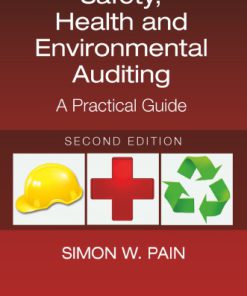The Art of Safety Auditing A Tutorial for Regulators 1st Edition by Sasho Andonov 0367351080 9780367351083
$50.00 Original price was: $50.00.$25.00Current price is: $25.00.
The Art of Safety Auditing: A Tutorial for Regulators 1st Edition by Sasho Andonov – Ebook PDF Instant Download/DeliveryISBN: 0367351080, 9780367351083
Full download The Art of Safety Auditing: A Tutorial for Regulators 1st Edition after payment.

Product details:
ISBN-10 : 0367351080
ISBN-13 : 9780367351083
Author: Sasho Andonov
The Art of Safety Auditing: A Tutorial for Regulators provides the theory and practice of auditing safety management systems implemented by the companies in risk industries. With his extensive knowledge and experiences in quality and safety, Sasho Andonov provides the tools to fill the gap in regulatory auditing for safety management systems. The book explains in detail the overall process of auditing with emphasis on practical execution of audits by Safety Regulators in each State or International Organizations. This book presents real examples and outlines every aspect of regulations and oversight audits in high risk industries. FEATURES Offers all theoretical and practical aspects of safety audits Dedicated to regulatory bodies and companies in high risk industries Provides a holistic approach to auditing as part of regulatory oversight activities Discusses most common mistakes during audits and advices how to correct them Excellent tool for auditors and safety managers, but can be utilized in other industries
The Art of Safety Auditing: A Tutorial for Regulators 1st Table of contents:
1 Introduction
1.1 Who Can Benefit from This Book?
1.2 General Explanation Regarding the Book
1.3 Axioms
2 Clarifications of General Terms
2.1 Introduction
2.2 Management and Engineering
2.3 Hazard, Threat, and Risk
2.4 Two Types of Safety
2.5 Quality versus Safety
2.6 Safety versus Security
2.7 Oversight versus Audit
2.8 Inspection versus Audit
2.9 Compliance versus Conformance
2.10 What Is a Management System?
2.11 Establishing a Management System
2.12 Understanding Procedures
2.13 Records
2.14 AMC
2.15 Validation versus Verification
2.16 Safety Case
2.17 Human Factors (HF)
2.18 Mistake versus Error
2.19 Just Culture
3 Regulation
3.1 Introduction
3.2 How to Pass a Regulation?
3.3 Accreditation, Certification, Licensing, Attestation, Approval
3.4 Standards versus Recommendations
3.5 Regulation and Regulators
3.6 “Grey Area” of Regulation
3.7 Regulation and Auditors
3.8 Post-holder
3.9 “Personality” of Regulators
3.10 Who to “Blame” If There Is Non-Compliance?
4 Types of Audits
4.1 Introduction
4.2 Internal Audits
4.3 External Audits
4.3.1 Second Party Audits
4.3.2 Third Party Audits
4.3.2.1 Categories of Third Party Audits
4.4 Frequency of Audits
5 Companies and Audits
5.1 Introduction
5.2 “Personality” of the Company
5.3 Understanding the Audit of the Company
5.3.1 What Is the Purpose of the Audit?
5.3.2 How the Companies Are Reacting to Audits
6 Check Lists (CLs)
6.1 Introduction
6.2 Two Types of Check Lists
6.2.1 Target Check Lists
6.2.2 Audit Check List
6.3 What to Do with Filled Audit CLs?
6.4 Compliance and Non-Compliance
6.5 Audit Software
7 Management of Findings
7.1 Introduction
7.2 Findings
7.3 Objective Evidence
7.4 Type of Findings
7.5 How to Present the Findings?
7.6 What Is Next?
8 Preparation for Audit
8.1 Introduction
8.2 Schedule of Audits
8.3 Establishing the Audit Team
8.4 Organizing the Approval Audit
8.4.1 Documentation Audit
8.4.2 Preparing On-Site Audit
8.4.3 Executing On-Site Audit
8.5 Sampling
8.5.1 How to Choose a Sample?
8.5.2 How to Use Sampling in Audits?
9 Conducting the Audit
9.1 Introduction
9.2 How to Do Auditing?
9.2.1 Auditing Documentation
9.2.2 Auditing Equipment
9.2.3 Auditing Employees’ Qualifications
9.2.4 Auditing Safety Policy
9.2.5 Auditing Safety Objectives
9.2.6 Auditing Procedures
9.2.7 Auditing Records
9.2.8 Auditing Preventive and Corrective Maintenance
9.2.9 Auditing Preventive and Corrective Actions
9.2.10 Auditing Management of Change
9.2.11 Auditing Alarm Systems
9.2.12 Auditing “Chronology of Events”
9.2.13 Auditing Human Factors (HF)
9.2.14 Auditing Process of Monitoring of SMS
9.2.15 Auditing Training in the Company
9.2.16 Auditing Handling, Storage, and Shipping
9.2.17 Auditing Internal Audits
9.2.18 Auditing Outsourcing and Partner Companies
9.3 Final Report
9.4 What Next?
9.5 The Regulator and the Outcomes from the Audits
10 “Challenges” for the Auditor during Audits
10.1 Introduction
10.2 Time Gap
10.3 Not Following the Audit Schedule
10.4 Company Does Not Allow Access to Some Premises
10.5 Company Is Lying
10.6 Auditor Found Something Which Is Not in Target CLs
10.7 There Is Not Enough Staff in Company to Maintain Safe Operations
11 Profile of the Auditor
11.1 Introduction
11.2 What Is Important for the Auditor?
11.3 Yearly Assessment of Auditors
11.4 Improvements of Auditors
11.5 Things for Which a Good Auditor Must Take Care
11.6 Qualities of Auditor
11.6.1 Training in Audits
11.6.2 Time Management
11.6.3 Honesty
11.6.4 Independence
11.6.5 Impartiality
11.6.6 Communication
11.6.7 Flexibility
11.6.8 Trustworthiness
11.6.9 Decisiveness
11.6.10 Analytical and Understanding
11.6.11 Persistence
11.6.12 Trust in the Instincts
11.6.13 Commitment and Determination
11.6.14 Professionalism
11.6.15 Team Work
11.7 The Most Important Thing!
People also search for The Art of Safety Auditing: A Tutorial for Regulators 1st:
what is the purpose of a safety audit
the art of software security assessment
art safety
the importance of safety audits
a safety audit covers which four general areas
Tags: The Art, Safety Auditing, Tutorial, Regulators, Sasho Andonov
You may also like…
Biology and other natural sciences
Commercial & Financial Law
Business & Economics - Human Resources
Computers - Computer Science
Business & Economics - Management & Leadership
Engineering - Environmental
Safety, Health and Environmental Auditing: A Practical Guide, Second Edition Simon Watson Pain
Business & Economics - Accounting












